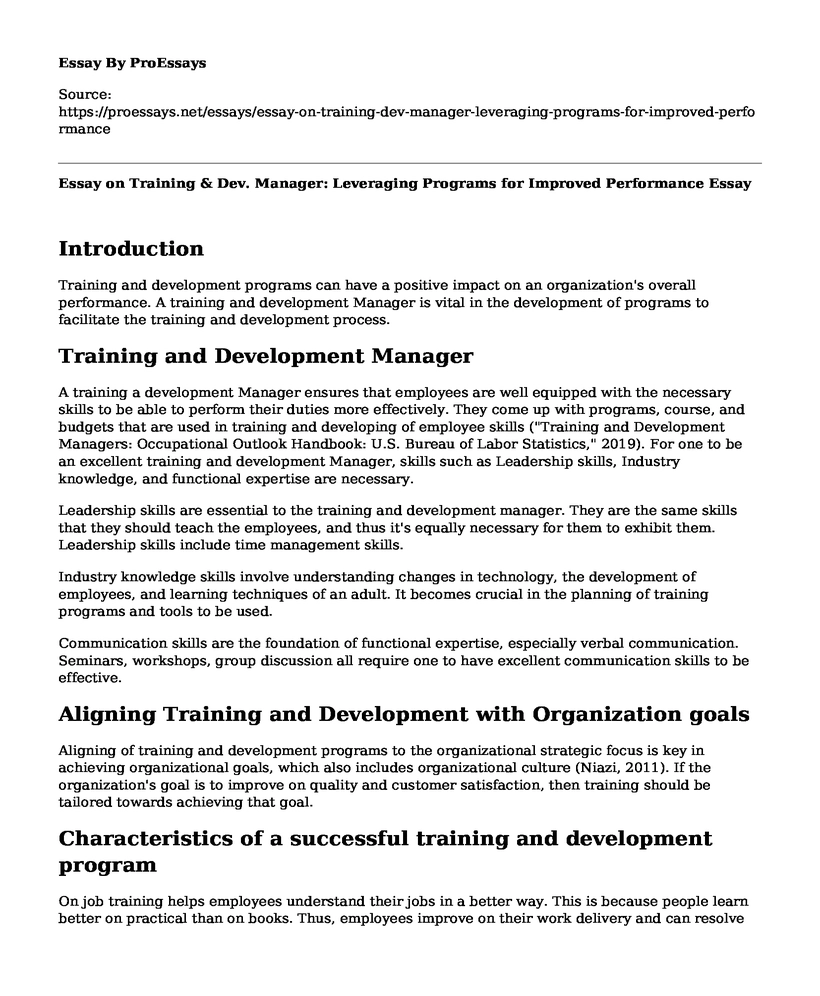Introduction
Training and development programs can have a positive impact on an organization's overall performance. A training and development Manager is vital in the development of programs to facilitate the training and development process.
Training and Development Manager
A training a development Manager ensures that employees are well equipped with the necessary skills to be able to perform their duties more effectively. They come up with programs, course, and budgets that are used in training and developing of employee skills ("Training and Development Managers: Occupational Outlook Handbook: U.S. Bureau of Labor Statistics," 2019). For one to be an excellent training and development Manager, skills such as Leadership skills, Industry knowledge, and functional expertise are necessary.
Leadership skills are essential to the training and development manager. They are the same skills that they should teach the employees, and thus it's equally necessary for them to exhibit them. Leadership skills include time management skills.
Industry knowledge skills involve understanding changes in technology, the development of employees, and learning techniques of an adult. It becomes crucial in the planning of training programs and tools to be used.
Communication skills are the foundation of functional expertise, especially verbal communication. Seminars, workshops, group discussion all require one to have excellent communication skills to be effective.
Aligning Training and Development with Organization goals
Aligning of training and development programs to the organizational strategic focus is key in achieving organizational goals, which also includes organizational culture (Niazi, 2011). If the organization's goal is to improve on quality and customer satisfaction, then training should be tailored towards achieving that goal.
Characteristics of a successful training and development program
On job training helps employees understand their jobs in a better way. This is because people learn better on practical than on books. Thus, employees improve on their work delivery and can resolve the different challenges they face on their day-to-day activities. On job training is also cost-effective and time-saving.
If the trainer is not delivering an exciting style and not catching the attention of the trainees, then that is a waste of time. A good delivering style should be engaging by making all audience participate in the learning process. This makes everybody be on board during the learning process.
Training and development, in the long run, improve employees' performance. This is because they are able and confident in their work. Training also inspires employees. It motivates them in doing their job more effectively.
How Measure the Impact of Training and Development Programs
In this section, measuring the impact of training and development programs involves the following:
In this section, you measure how the trainee was engaged? How actively they contributed and how they received it. This can be done making a simple questionnaire that asks them simple questions like; was the training worth your time? Was it successful? How were the venue and the presentation? If the questions are answered, then you would have measured the reaction of the employee on the training and development program.
An assessment should be done to know what the employees learned at the training. Questions like what they did or did not learn how motivated they are after the training should measure the impact of the training process.
In this section, it involves monitoring the behavior of the employees after the training. Behavior change is connected with developments made in the company to allow new knowledge. For example, employees may be willing to put into practice what they have learned, but organizational culture and structural processes make that difficult.
Results are the ultimate measure to know the impact of the training and development programs. The results may include; increased customer satisfaction, fewer staff complaints, increased employee retention, increased sales, and higher morale. The results will depend on the organizational goal.
Conclusion
In conclusion, having a training and development manager increases performance and also enhances the achievement of organizational goals.
References
Ghafoor, R. A., Khan, F. A., & Khan, M. A. (2011). Impact of Training and Development on Organizational Performance. Global Journal of Management and Business Research, 11(7). Retrieved from https://globaljournals.org/GJMBR_Volume11/8-Impact-of-Training-and-Development-on-Organizational-Performance.pdf
Niazi, A. S. (2011). Journal of Public Administration and Governance, Vol. 1, No. 1 July (2011). Journal of Public Administration and Governance, 1(2), 42-57. doi:10.5296/jpag.v1i1.822
Training and Development Managers : Occupational Outlook Handbook: : U.S. Bureau of Labor Statistics. (2019, June 18). Retrieved from https://www.bls.gov/ooh/management/training-and-development-managers.htm#tab-2
Cite this page
Essay on Training & Dev. Manager: Leveraging Programs for Improved Performance. (2023, Feb 11). Retrieved from https://proessays.net/essays/essay-on-training-dev-manager-leveraging-programs-for-improved-performance
If you are the original author of this essay and no longer wish to have it published on the ProEssays website, please click below to request its removal:
- Essay on Evaluation of Learning and Development
- Countrywide Financial Corp Case Study Paper Example
- Teachers Pay Essay Example
- Essay on Consumer Behaviour: Understanding Shopping Habits and Decision Making
- My Dream to Advance My Career: Pursuing an MBA in Marketing - Essay Sample
- Report Example on Remote Work Policies: Guidelines for Flexible Working
- Essay Example: Maximizing Profits with Unique Management Tactics & Leadership Styles







